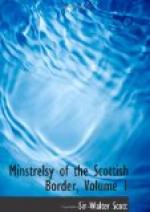[Footnote 7: The particulars of this encounter are interesting. The Hamiltons were the most numerous party, drawn chiefly from the western counties. Their leaders met in the palace of Archbishop Beaton, and resolved to apprehend Angus, who was come to the city to attend the convention of estates. Gawain Douglas, bishop of Dunkeld, a near relation of Angus, in vain endeavoured to mediate betwixt the factions. He appealed to Beaton, and invoked his assistance to prevent bloodshed. “On my conscience,” answered the archbishop, “I cannot help what is to happen.” As he laid his hand upon his breast, at this solemn declaration, the hauberk, concealed by his rocket, was heard to clatter: “Ah! my lord!” retorted Douglas, “your conscience sounds hollow.” He then expostulated with the secular leaders, and Sir Patrick Hamilton, brother to Arran, was convinced by his remonstrances; but Sir James, the natural son of the earl, upbraided his uncle with reluctance to fight. “False bastard!” answered Sir Patrick, “I will fight to day where thou darest not be seen.” With these words they rushed tumultuously towards the high-street, where Angus, with the prior of Coldinghame, and the redoubted Wedderburn, waited their assault, at the head of 400 spearmen, the flower of the east marches, who, having broke down the gate of the Netherbow, had arrived just in time to the earl’s assistance. The advantage of the ground, and the disorder of the Hamiltons, soon gave the day to Angus. Sir Patrick Hamilton, and the master of Montgomery, were slain. Arran, and Sir James Hamilton, escaped with difficulty; and with no less difficulty was the military prelate of Glasgow rescued from the ferocious borderers, by the generous interposition of Gawain Douglas. The skirmish was long remembered in Edinburgh, by the name of “Cleanse the Causeway.”—Pinkerton’s History, Vol. II. p. 181.—Pitscottie Edit. 1728. p. 120.—Life of Gawain Douglas, prefixed to his Virgil.]
The return of the regent was followed by the banishment of Angus, and by a desultory warfare with England, carried on with mutual incursions. Two gallant armies, levied by Albany, were dismissed without any exploit worthy notice, while Surrey, at the head of ten thousand cavalry, burned Jedburgh, and laid waste all Tiviotdale. This general pays a splendid tribute to the gallantry of the border chiefs. He terms them “the boldest [Sidenote: 1523] men, and the hottest, that ever I saw any nation[8].”
[Footnote 8: A curious letter from Surrey to the king is printed in the Appendix, No. I.]
Disgraced and detested, Albany bade adieu to Scotland for ever. The queen-mother, and the Earl of Arran, for some time swayed the kingdom. But their power was despised on the borders, where Angus, though banished, had many friends. Scot of Buccleuch even appropriated to himself domains, belonging to the queen, worth 4000 merks yearly; being probably the castle of Newark and her jointure lands in Ettrick forest[9].—




